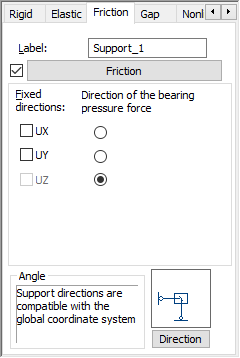When the Friction tab is selected from the Support Definition dialog, the following dialog displays.

The options on this tab lets you define a support type that considers friction. When the check box next to the Friction button is selected ( ),the Direction of the bearing pressure force options are available. Clicking Friction opens another dialog for defining following values:
),the Direction of the bearing pressure force options are available. Clicking Friction opens another dialog for defining following values:
- Friction coefficient mi
- Cohesion To
- Coefficient gM.
A basic friction characteristic is the friction coefficient mi. Its value when multiplied by a force acting on a selected direction (for each case), yields a value of the limit force on the released directions.
The cohesion force, that is, the limit friction force if no bearing pressure occurs, is calculated as well. The bearing pressure forces are analyzed only when the specified value is exceeded.
Also, the dialog has the safety coefficient gM (1.00 by default). A value of the friction coefficient is divided by the value of the specified safety coefficient.

When one of the directions of the bearing pressure force is selected, the Fixed directions option on this level is not available. For 3D structures, at least 1 direction (for 2D structures - at least1 direction) must be released for friction to work correctly in the support. For any other case, Robot displays an error message about an incorrect support definition during structure calculations.
If a transverse external force is less than the friction force from bearing pressure, then a support works like a rigid support (with great elasticity) or an elastic support (with a value of the elastic coefficient specified by a user). If the external force is greater, the released direction is treated as a direction on which movement is allowed.
You can define friction with uplift. Forces with the orientation compatible with uplift do not produce friction at the support (a roller support model is created). Only the direction opposite to the uplift results in friction. When None is selected, friction is not based on the orientation of the normal force action.
During structure calculations for each case, the following conditions are checked at each support with friction defined:
- for 3D structures (if two directions are released):
- Ffrict (dir 1) ≤ mi * Fn / gM + To
- Ffrict (dir 2) ≤ mi * Fn / gM + To
- for 2D structures:
- Ffrict ≤ mi * Fn / gM + To
If the supports meet the previous conditions, a reaction force displays. If these conditions are not met, the support is treated as a roller support.
Examples of friction coefficients for building materials
|
Materials |
Range of friction coefficients |
|---|---|
|
Concrete - concrete |
0.5 - 1.0 |
|
Steel - concrete |
0.3 - 0.4 |
|
Steel - steel |
0.2 - 0.8 |
|
Timber - concrete |
0.8 - 1.0 |
|
Timber - steel |
0.5 - 1.2 |
|
Timber - timber |
0.4 - 1.0 |
|
Rubber - concrete (dry) |
1.0 |
|
Rubber - concrete (wet) |
0.30 |